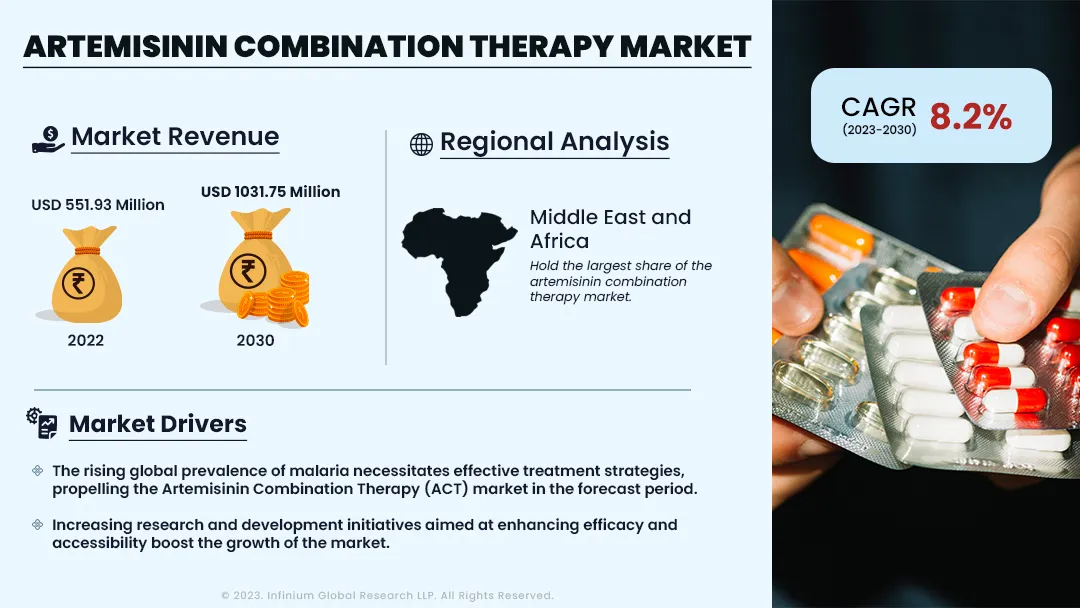Artemisinin Combination Therapy Market (Therapy Type - Artesunate-amodiaquine, Artemether-lumefantrine, Dihydroartemisinin-piperaquine, Artesunate-sulfadoxine-pyrimethamine, Pyronaridine-artesunate, and Artesunate-mefloquine; Distribution Channel - Hospitals, Clinics and Pharmacies, Retail and Drug Stores, and Others): Global Industry Analysis, Trends, Size, Share and Forecasts to 2030
A recent report published by Infinium Global Research on artemisinin combination therapy market provides in-depth analysis of segments and sub-segments in the global as well as regional artemisinin combination therapy market. The study also highlights the impact of drivers, restraints, and macro indicators on the global and regional artemisinin combination therapy market over the short term as well as long term. The report is a comprehensive presentation of trends, forecast and dollar values of global artemisinin combination therapy market.
Market Insight:
Artemisinin is a derivative of a plant extracted from Artemisia annua, that has been shown to reduce the number of plasmodium parasites in malaria patients' blood effectively and quickly. For uncomplicated falciparum malaria, artemisinin-based combination therapies (ACTs) are now widely regarded as the most effective treatment. They work quickly and consistently. Artemisinin combination therapy became the first line of treatment as sulfadoxine-pyrimethamine and chloroquine became ineffective and non-lethal as falciparum malaria bacteria developed a resistance towards these drugs. Even the World Health Organization has classified artemisinin combination therapy as the primary treatment of uncomplicated falciparum malaria. The artemisinin combination therapy types are Artesunate-Amodiaquine, Artemether-Lumefantrine, Dihydroartemisinin-Piperaquine, Artesunate-Sulfadoxine-Pyrimethamine, Pyronaridine-Artesunate, Artesunate-Mefloquine and can be accessed through hospitals, clinics, pharmacies, and other distribution channels. Additionally, collaborations between governments, non-profit organizations, and pharmaceutical companies aim to enhance the accessibility and affordability of ACT in malaria-endemic regions. The ACT market's growth is intertwined with broader global health initiatives, reflecting the collective commitment to eradicating malaria and improving healthcare outcomes for vulnerable populations.
The rising global prevalence of malaria necessitates effective treatment strategies, propelling the Artemisinin Combination Therapy (ACT) market in the forecast period. Malaria remains a significant global health concern, particularly in tropical and subtropical regions, affecting millions of individuals annually. The urgency to address this public health challenge amplifies the necessity for potent and reliable treatment options. ACT, endorsed by international health organizations, stands at the forefront due to its proven efficacy in rapidly clearing parasites and reducing the risk of resistance. Additionally, increasing research and development initiatives aimed at enhancing efficacy and accessibility boost the growth of the market. Collaborations between governments, pharmaceutical companies, and non-profit organizations foster innovation and improve drug formulations, ensuring the continued effectiveness of ACT in the face of emerging challenges such as drug resistance. These dual drivers, fueled by advancements in treatment options, propel the artemisinin combination therapy market. However, the artemisinin combination therapy is costly which is expected to restrain the growth of the market. Furthermore, increasing collaboration between governments, pharmaceutical companies, and NGOs creates an opportunity to enhance the artemisinin combination therapy (ACT) market.

The Middle East and Africa hold the largest share of the artemisinin market. This supremacy is attributed due to the presence of a large production base of artemisinin herbs and rising demand in malaria-endemic countries are contributing to the growth of the market in MEA. Though African countries, where the incidence of malaria is the highest, have increased malaria control strategies, effective treatment, and control, it still presents a huge logistical difficulty. As several at-risk people live in extreme poverty in remote areas, WHO and other organizations are working on completely eradicating it in Africa, and thus, over the coming years, the adoption rate of ACT is further expected to increase. Moreover, the Asia-Pacific (APAC) region showed the fastest growth in the artemisinin combination therapy market due to its increasing population, economic development, and expanding healthcare infrastructure. The adoption of new treatment options, as well as a growing focus on preventative measures, contributed to this growth. The emergence of drug-resistant malaria strains in the region also necessitated ongoing research and development efforts, further driving the market.
Report Scope of the Artemisinin Combination Therapy Market:
| Report Coverage | Details |
|---|---|
| Market Size in 2022 | USD 551.93 Million |
| Market Size by 2030 | USD 1031.75 Million |
| Growth Rate from 2023 to 2030 | CAGR of 8.2% |
| Largest Market | Middle East and Africa |
| No. of Pages | 180 |
| Market Drivers |
|
| Market Segmentation | By Therapy Type, and By Distribution Channel |
| Regional Scope | North America, Europe, Asia Pacific, and RoW |
Segment wise revenue contribution in the global artemisinin combination therapy market
The report on global artemisinin combination therapy market provides a detailed analysis of segments in the market based on Therapy Type, and Distribution Channel.
Segmentation Based on Therapy Type
· Artesunate-amodiaquine
· Artemether-lumefantrine
· Dihydroartemisinin-piperaquine
· Artesunate-sulfadoxine-pyrimethamine
· Pyronaridine-artesunate
· Artesunate-mefloquine
Segmentation Based on Distribution Channel
· Hospitals
· Clinics and Pharmacies
· Retail and Drug Stores
· Others
Company Profiled:
· Novartis AG
· Cipla Inc.
· Sanofi S.A.
· Shanghai Desano Pharmaceuticals Co., Ltd.
· KPC Pharmaceuticals Inc
· Guilin Nanyao Co., Ltd.
· Calyx Chemicals & Pharmaceuticals Ltd.
· DENK PHARMA GmbH & Co. KG
· Mylan N.V.
· Hovid Berhad
Report Highlights:
The report provides deep insights into demand forecasts, market trends, and micro and macro indicators. In addition, this report provides insights into the factors that are driving and restraining the growth in this market. Moreover, The IGR-Growth Matrix analysis given in the report brings an insight into the investment areas that existing or new market players can consider. The report provides insights into the market using analytical tools such as Porter's five forces analysis and DRO analysis of the artemisinin combination therapy market. Moreover, the study highlights current market trends and provides forecasts from 2023-2030. We also have highlighted future trends in the market that will affect the demand during the forecast period. Moreover, the competitive analysis given in each regional market brings an insight into the market share of the leading players.
